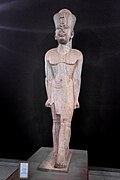Wikipedia:Today's featured article/requests/Atlanersa
Atlanersa[edit]
- This is the archived discussion of the TFAR nomination for the article below. Subsequent comments should be made on the appropriate discussion page (such as Wikipedia talk:Today's featured article/requests). Please do not modify this page.
The result was: scheduled for Wikipedia:Today's featured article/November 13, 2019 by Ealdgyth - Talk 14:06, 27 October 2019 (UTC)
Atlanersa was a Kushite ruler of the Napatan kingdom of Nubia in modern-day Sudan, reigning for about a decade in the mid-7th-century BC. He was the successor of Tantamani, the last ruler of the 25th Dynasty of Egypt, and possibly a son of Taharqa. Atlanersa's reign immediately followed the collapse of Nubian control over Egypt, which witnessed the conquest by the Assyrians and then the beginning of the Late Period under Psamtik I. The same period also saw the progressive cultural integration of Egyptian beliefs by the Kushite civilization. Atlanersa built a pyramid in the necropolis of Nuri, which produced many small artefacts now on display in the Museum of Fine Arts in Boston. Atlanersa's most prominent construction is his temple to the syncretic god Osiris-Dedwen in Jebel Barkal, which he was able to finish and partially decorate. The temple entrance was to be flanked with two colossal statues of the king, one of which was completed and set in place and is now in the National Museum of Sudan. (Full article...)
- Most recent similar article(s): There is no FA article at all on Sudanese history, nor any other FA article on Kushite kings.
- Main editors: Iry-Hor
- Promoted: 22 October 2019
- Reasons for nomination: I nominate this article as it is quite possibly the only FA article pertaining to Sudan on Wikipedia. It is very certainly the only FA article on Sudanese antiquity: as such, there never were any TFA on a Kushite king. Even though Atlanersa liked to style himself as an Egyptian king, he wasn't one and did not reign over Egypt. Yet, he lived at a pivotal time in the history of the Kushite kingdom, when Egyptian cultural concepts got assimilated by the Kushite civilisation. This deeply marked the co-evolution of Sudan and Egypt, from the 7th century BC onwards. This, in turn, has stark relevance on the modern scene, which currently sees the rise of tensions between Egypt, Sudan and Ethiopia over the use of the Nile and a new dam project.
- Support as nominator. Iry-Hor (talk) 14:12, 22 October 2019 (UTC)
- Support, with a tiny tweak. - Dank (push to talk) 15:58, 22 October 2019 (UTC) (FWIW, this one was just promoted, so this TFAR serves as the blurb review.) - Dank (push to talk) 00:22, 23 October 2019 (UTC)
- Support. Reidgreg (talk) 22:56, 22 October 2019 (UTC)
- Support Aoba47 (talk) 01:14, 23 October 2019 (UTC)
- Support but just wondering if it would be improved by a reference early in the blurb about where Nubia is, along the lines of "... Napatan kingdom of Nubia, located in what is now Sudan,..." Particularly as the next two sentences both mention only Egypt. This could lead most readers to think we are talking about a location in contemporary Egypt. Or if we are uncomfortable with using modern nation-state references then how about "... Napatan kingdom of Nubia, on the central reaches of the Nile"? hamiltonstone (talk) 03:24, 23 October 2019 (UTC)
- Sure, I therefore propose the alternative: "Atlanersa was a Kushite ruler of the Napatan kingdom of Nubia in modern day Sudan, reigning for about a decade in the mid-7th-century BC" then the rest of the blurb would remain unchanged.Iry-Hor (talk) 07:37, 23 October 2019 (UTC)
- Done. - Dank (push to talk) 11:39, 23 October 2019 (UTC)
- Sure, I therefore propose the alternative: "Atlanersa was a Kushite ruler of the Napatan kingdom of Nubia in modern day Sudan, reigning for about a decade in the mid-7th-century BC" then the rest of the blurb would remain unchanged.Iry-Hor (talk) 07:37, 23 October 2019 (UTC)

